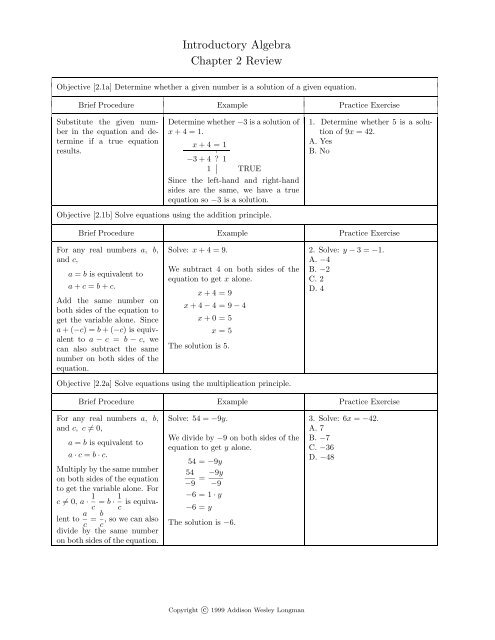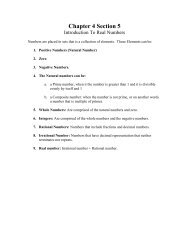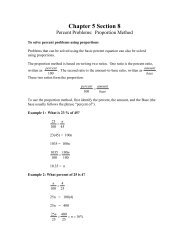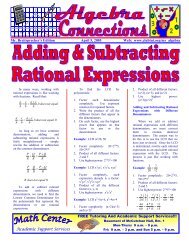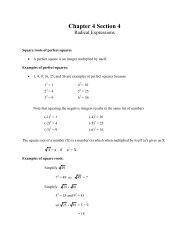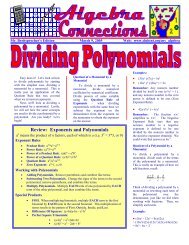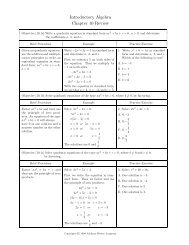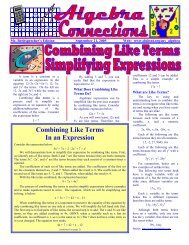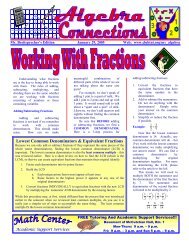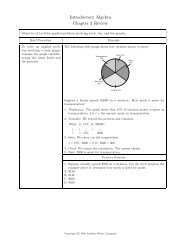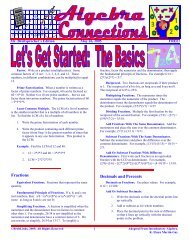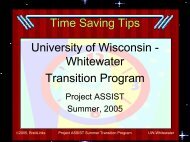Introductory Algebra Chapter 2 Review - Club TNT
Introductory Algebra Chapter 2 Review - Club TNT
Introductory Algebra Chapter 2 Review - Club TNT
Create successful ePaper yourself
Turn your PDF publications into a flip-book with our unique Google optimized e-Paper software.
<strong>Introductory</strong> <strong>Algebra</strong><br />
<strong>Chapter</strong> 2 <strong>Review</strong><br />
Objective [2.1a] Determine whether a given number is a solution of a given equation.<br />
Brief Procedure Example Practice Exercise<br />
Substitute the given number<br />
in the equation and determine<br />
if a true equation<br />
results.<br />
Determine whether −3 is a solution of<br />
x +4=1.<br />
x +4=1<br />
−3+4?1<br />
1 ∣ TRUE<br />
Since the left-hand and right-hand<br />
sides are the same, we have a true<br />
equation so −3 is a solution.<br />
Objective [2.1b] Solve equations using the addition principle.<br />
1. Determine whether 5 is a solution<br />
of 9x = 42.<br />
A. Yes<br />
B. No<br />
Brief Procedure Example Practice Exercise<br />
For any real numbers a, b,<br />
and c,<br />
a = b is equivalent to<br />
a + c = b + c.<br />
Add the same number on<br />
both sides of the equation to<br />
get the variable alone. Since<br />
a +(−c) =b +(−c) is equivalent<br />
to a − c = b − c, we<br />
can also subtract the same<br />
number on both sides of the<br />
equation.<br />
Solve: x +4=9.<br />
We subtract 4 on both sides of the<br />
equation to get x alone.<br />
x +4=9<br />
x +4− 4=9− 4<br />
x +0=5<br />
x =5<br />
The solution is 5.<br />
Objective [2.2a] Solve equations using the multiplication principle.<br />
2. Solve: y − 3=−1.<br />
A. −4<br />
B. −2<br />
C. 2<br />
D. 4<br />
Brief Procedure Example Practice Exercise<br />
For any real numbers a, b,<br />
and c, c ≠0,<br />
a = b is equivalent to<br />
a · c = b · c.<br />
Multiply by the same number<br />
on both sides of the equation<br />
to get the variable alone. For<br />
c ≠0,a · 1<br />
c = b · 1 is equivalent<br />
to a c = b , so we can also<br />
c<br />
c<br />
divide by the same number<br />
on both sides of the equation.<br />
Solve: 54 = −9y.<br />
We divide by −9 on both sides of the<br />
equation to get y alone.<br />
54 = −9y<br />
54<br />
−9 = −9y<br />
−9<br />
−6 =1· y<br />
−6 =y<br />
The solution is −6.<br />
3. Solve: 6x = −42.<br />
A. 7<br />
B. −7<br />
C. −36<br />
D. −48<br />
Copyright c○ 1999 Addison Wesley Longman
Objective [2.3a] Solve equations using both the addition and the multiplication principles.<br />
Brief Procedure Example Practice Exercise<br />
First use the addition principle<br />
to isolate the term that<br />
contains the variable. Then<br />
use the multiplication principle<br />
to get the variable by<br />
itself.<br />
Solve: 2x − 5=3.<br />
2x − 5=3<br />
2x − 5+5=3+5<br />
2x =8<br />
2x<br />
2 = 8 2<br />
x =4<br />
The solution is 4.<br />
4. Solve: 3y +1=−8.<br />
A. − 7 3<br />
B. − 8 3<br />
C. −3<br />
D. −11<br />
Objective [2.3b] Solve equations in which like terms may need to be collected.<br />
Brief Procedure Example Practice Exercise<br />
If there are like terms on one<br />
side of the equation, collect<br />
them before using the addition<br />
or multiplication principle.<br />
If there are like terms<br />
on opposite sides of the equation,<br />
use the addition principle<br />
to get all terms with a<br />
variable on one side and all<br />
numbers on the other.<br />
Solve: 2y − 1=−3y − 8+2.<br />
2y − 1=−3y − 8+2<br />
2y − 1=−3y − 6<br />
2y − 1+1=−3y − 6+1<br />
2y = −3y − 5<br />
2y +3y = −3y − 5+3y<br />
5y = −5<br />
5y<br />
5 = −5<br />
5<br />
y = −1<br />
The solution is −1.<br />
5. Solve: 3x − 5 − x =6x +7.<br />
A. −3<br />
B. −1<br />
C. 1 4<br />
D. 3 2<br />
Objective [2.3c] Solve equations by first removing parentheses and collecting like terms.<br />
Brief Procedure Example Practice Exercise<br />
If an equation contains parentheses,<br />
first use the distributive<br />
laws to remove<br />
them. Then collect like<br />
terms, if necessary, and use<br />
the addition and multiplication<br />
principles to complete<br />
the solution of the equation.<br />
Solve: 8b − 2(3b + 1) = 10.<br />
8b − 2(3b +1)=10<br />
8b − 6b − 2=10<br />
2b − 2=10<br />
2b − 2+2=10+2<br />
2b =12<br />
2b<br />
2 = 12<br />
2<br />
b =6<br />
The solution is 6.<br />
6. Solve: 3(n − 4)=2(n + 1).<br />
A. −5<br />
B. −2<br />
C. 5<br />
D. 14<br />
Copyright c○ 1999 Addison Wesley Longman
Objective [2.4a] Solve applied problems by translating to equations.<br />
Brief Procedure Example Practice Exercise<br />
Use the five-step problem<br />
solving process.<br />
1. Familiarize yourself with<br />
the problem situation.<br />
2. Translate the problem to<br />
an equation.<br />
3. Solve the equation.<br />
4. Check the answer in the<br />
original problem.<br />
5. State the answer to the<br />
problem clearly.<br />
A 12-ft pipe is cut into three pieces.<br />
The second piece is three times as<br />
long as the first. The third piece is<br />
twice as long as the first. How long is<br />
each piece?<br />
1. Familiarize. Let x = the length of<br />
the first piece of pipe. Then 3x =<br />
the length of the second piece and<br />
2x = the length of the third piece.<br />
2. Translate. We use the fact that the<br />
sum of the lengths is 12 feet.<br />
Length<br />
of first<br />
}<br />
piece<br />
{{ }<br />
plus<br />
length<br />
of second<br />
}<br />
piece<br />
{{ }<br />
plus<br />
↓ ↓ ↓ ↓<br />
x + 3x +<br />
length<br />
of third<br />
}<br />
piece<br />
{{ }<br />
total<br />
is<br />
length<br />
} {{ }<br />
↓ ↓ ↓<br />
2x = 12<br />
3. Solve. We solve the equation.<br />
x +3x +2x =12<br />
6x =12<br />
6x<br />
6 = 12<br />
6<br />
x =2<br />
If x = 2, then 3x =3· 2, or 6, and<br />
2x =2· 2, or 4.<br />
4. Check. The second piece, 6 ft, is<br />
three times as long as the first, 2 ft,<br />
and the third piece, 4 ft, is twice as<br />
long as the first. Also, the lengths<br />
total 2 ft +6ft+4ft,or12ft.<br />
The answer checks.<br />
5. State. The first piece of pipe is 2 ft<br />
long, the second piece is 6 ft, and<br />
the third piece is 4 ft.<br />
7. The perimeter of a rectangular<br />
rug is 40 ft. The width is 4 ft<br />
less than the length. Find the<br />
dimensions of the rug.<br />
A. The width is 8 ft.<br />
B. The width is 10 ft.<br />
C. The width is 12 ft.<br />
D. The width is 16 ft.<br />
Copyright c○ 1999 Addison Wesley Longman
Objective [2.5a] Solve applied problems involving percent.<br />
Brief Procedure Example Practice Exercise<br />
Use the five-step problem<br />
solving process.<br />
An investment is made at 8% simple<br />
interest for 1 year. It grows to $2700.<br />
How much was originally invested?<br />
1. Familiarize. Recall the formula for<br />
simple interest, I = Prt, where<br />
I is the interest, P is the principal<br />
(the amount invested), r is the<br />
interest rate, and t is the length<br />
of time the principal is invested.<br />
Let x = the amount originally invested.<br />
Then the interest earned<br />
in 1 year is x · 8% · 1, or 8%x. The<br />
principal plus the interest is the<br />
amount to which the investment<br />
grows after 1 year.<br />
2. Translate. We reword the problem<br />
and translate.<br />
8. After a 25% price reduction, a<br />
CD is on sale for $13.50. What<br />
was the original price?<br />
A. $16<br />
B. $16.88<br />
C. $18<br />
D. $19.75<br />
Principal plus Interest = Amount<br />
↓ ↓ ↓<br />
x + 8%x = 2700<br />
3. Solve. We solve the equation.<br />
x +8%x = 2700<br />
x +0.08x = 2700<br />
1x +0.08x = 2700<br />
1.08x = 2700<br />
1.08x<br />
1.08 = 2700<br />
1.08<br />
x = 2500<br />
4. Check. We check by finding 8% of<br />
$2500 and adding it to $2500:<br />
8% × $2500 = 0.08 × $2500 = $200<br />
and $2500 + $200 = $2700.<br />
The answer checks.<br />
5. State. The original investment was<br />
$2500.<br />
Copyright c○ 1999 Addison Wesley Longman
Objective [2.6a] Evaluate formulas and solve a formula for a specified letter.<br />
Brief Procedure Example Practice Exercises<br />
To evaluate a formula for a<br />
given value of the variable,<br />
substitute the value for the<br />
variable and carry out the resulting<br />
calculations.<br />
To solve a formula for a specified<br />
letter, identify the letter<br />
and:<br />
1. Multiply on both sides<br />
to clear fractions or decimals,<br />
if that is needed.<br />
2. Collect like terms on each<br />
side, if necessary.<br />
3. Get all terms with<br />
the letter to be solved for<br />
on one side of the equation<br />
and all other terms on the<br />
other side.<br />
4. Collect like terms again, if<br />
necessary.<br />
5. Solve for the letter in<br />
question.<br />
The formula d = 65t gives the distance<br />
d that is traveled in t hours at a<br />
speed of 65 mph. Suppose you travel<br />
at 65 mph for 4 hours. How far have<br />
you traveled?<br />
We substitute 4 for t and carry out<br />
the calculation.<br />
d =65· 4 = 260<br />
You have traveled 260 miles.<br />
Solve for b: A = a + b<br />
2 .<br />
A = a + b<br />
2<br />
( ) a + b<br />
2 · A =2<br />
2<br />
2A = a + b<br />
2A − a = b<br />
9. Using the formula d =65t, find<br />
the distance traveled at 65 mph<br />
for 3 hours.<br />
A. 185 miles<br />
B. 195 miles<br />
C. 205 miles<br />
D. 225 miles<br />
10. Solve for h: A = 1 2 bh.<br />
A. h = A 2b<br />
B. h = b<br />
2A<br />
C. h = 2b<br />
A<br />
D. h = 2A b<br />
Objective [2.7a] Determine whether a given number is a solution of an inequality.<br />
Brief Procedure Example Practice Exercise<br />
Substitute the given number<br />
for the variable and determine<br />
if a true inequality<br />
results.<br />
Determine whether each number is a<br />
solution of y ≤−4.<br />
a) 2 b) −4<br />
a) Since 2 ≤−4 is false, 2 is not a<br />
solution.<br />
b) Since −4 ≤ −4 is true, −4 isa<br />
solution.<br />
11. Determine whether −3 isasolution<br />
of x ≥−5.<br />
A. Yes<br />
B. No<br />
Copyright c○ 1999 Addison Wesley Longman
Objective [2.7b] Graph an inequality on a number line.<br />
Brief Procedure Example Practice Exercise<br />
Shade all points on the number<br />
line that are solutions of<br />
the given inequality.<br />
Graph each inequality.<br />
a) x 3x +1.<br />
4x − 2 > 3x +1<br />
4x − 2+2> 3x +1+2<br />
4x >3x +3<br />
4x − 3x >3x +3− 3x<br />
x>3<br />
The solution set is {x|x >3}.<br />
13. Solve: x +7≤ 5.<br />
A. {x|x ≤−12}<br />
B. {x|x ≤−2}<br />
C. {x|x ≤ 2}<br />
D. {x|x ≤ 12}<br />
Copyright c○ 1999 Addison Wesley Longman
Objective [2.7d] Solve inequalities using the multiplication principle.<br />
Brief Procedure Example Practice Exercise<br />
For any real numbers, a, b,<br />
and any positive number c:<br />
abc.<br />
For any real numbers, a, b,<br />
and any negative number c:<br />
abc;<br />
a>bis equivalent to ac15.<br />
−3y >15<br />
−3y<br />
−3 < 15<br />
−3<br />
y 9<br />
13 }<br />
D. {y|y >3}<br />
Brief Procedure Example Practice Exercise<br />
Read the sentence carefully<br />
and then translate to an<br />
inequality.<br />
Sarah works at least 15 hours each<br />
week.<br />
h ≥ 15<br />
16. Joe’s budget allows $20 per<br />
week, at most, for entertainment.<br />
A. E20<br />
D. E ≥ 20<br />
Copyright c○ 1999 Addison Wesley Longman
Objective [2.8b] Solve applied problems using inequalities.<br />
Brief Procedure Example Practice Exercise<br />
Use the five-step problem<br />
solving process.<br />
The perimeter of a rectangular patio<br />
is not to exceed 60 ft. The length is<br />
to be twice the width. What widths<br />
will meet these conditions?<br />
1. Familiarize. Recall that the formula<br />
for the perimeter P of a rectangle<br />
is P =2l+2w, where l is the<br />
length and w is the width. Since<br />
the length is twice the width, we<br />
have l =2w and then 2l +2w =<br />
2 · 2w +2w =4w +2w =6w.<br />
2. Translate. We reword the problem<br />
and translate.<br />
Perimeter<br />
} {{ }<br />
is less than<br />
or equal to<br />
} {{ }<br />
60 ft.<br />
} {{ }<br />
↓ ↓ ↓<br />
6w ≤ 60<br />
3. Solve. We solve the inequality.<br />
6w ≤ 60<br />
6w<br />
6 ≤ 60<br />
6<br />
w ≤ 10<br />
4. Check. We can obtain a partial<br />
check by substituting a number<br />
less than or equal to 10 for w.<br />
For example, for w =9:<br />
6w =6· 9=54≤ 60.<br />
The result is probably correct.<br />
5. State. Widths less than or<br />
equal to 10 ft will meet the given<br />
conditions.<br />
17. Kelly’s scores on the first three<br />
tests in her physics class are 79,<br />
84, and 68. Determine all scores<br />
on the fourth test that will yield<br />
an average test score of at least<br />
80.<br />
A. Scores of 88 or higher<br />
B. Scores of 89 or higher<br />
C. Scores of 91 or higher<br />
D. Scores of 94 or higher<br />
Copyright c○ 1999 Addison Wesley Longman


